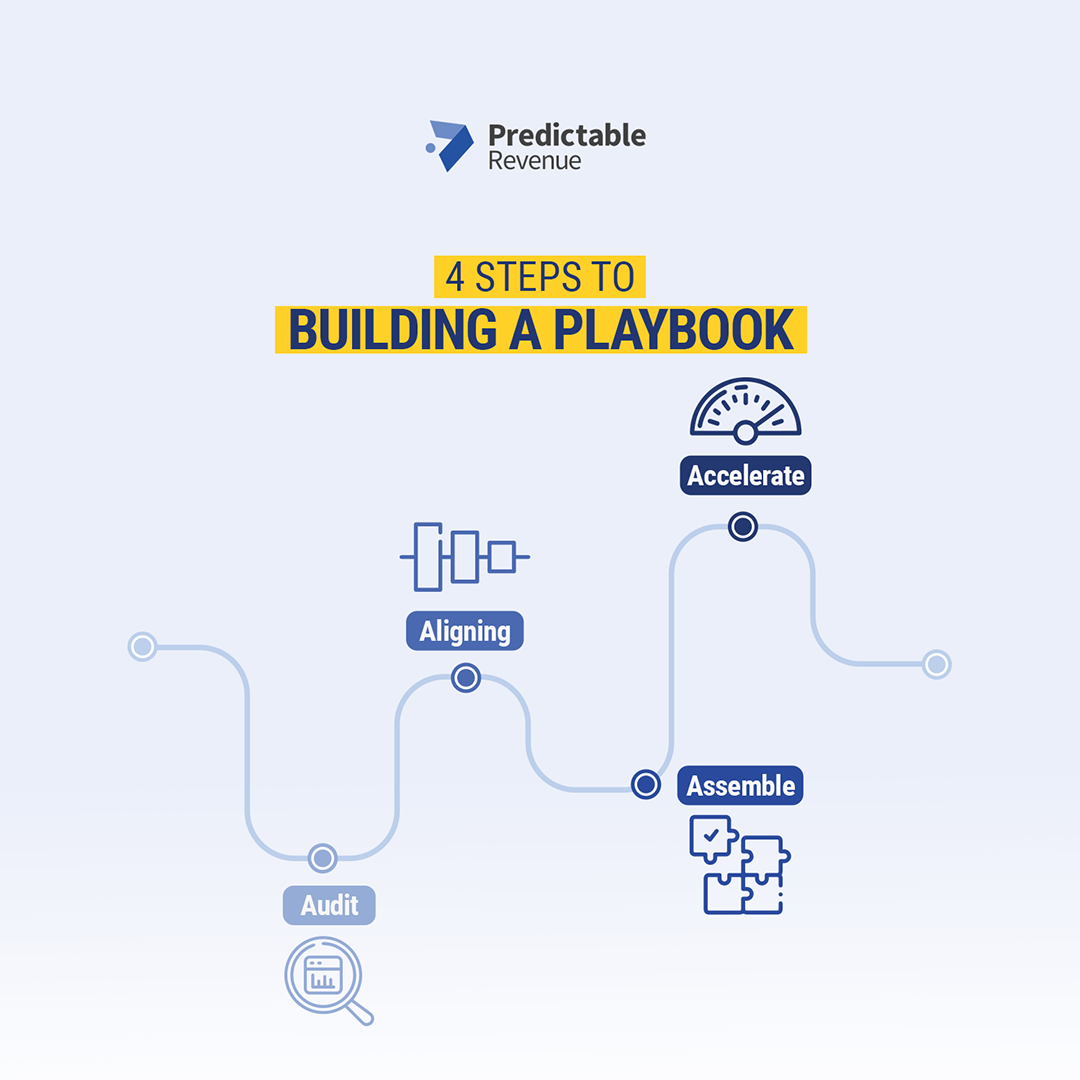Build Your Sales Playbook in 4 Easy Steps

Drew Williams is the founder of Sales Playbook Builder. Drawing on his extensive experience in sales gained over a 17-year long career in the field, he coaches founders, CEOs, owners, partners, and entrepreneurs to build high performing sales teams and effective sales playbooks. He joined Predictable Revenue to run a workshop on building sales playbooks in four easy steps.
The aim of this session is to help you build a repeatable, scalable sales culture from scratch. Specifically, it will cover how to approach building your playbook. “I’ve got a great, easy, four-step process that I’m going to share with you,” Drew shares. And it’s something you can use on an ongoing basis too. “A playbook shouldn’t just sit on your shelf – it’s something that you constantly revisit.”
Common Challenges To Building Your Sales Culture
Whether you are a CEO, a founder, a sales team leader, or any other person with a position of authority in a sales environment, there are some common challenges that you’re likely encountering. Dealing with these can be an important precursor to developing your sales playbook. Let’s take a look at some of these below.
Making Salespeople Follow Processes
When building out your new processes, you might have experienced some difficulty in making your salespeople follow them. It’s often down to an adoption issue. It’s not unusual for salespeople to prefer doing things in their own way. Alternatively, it could be a problem with the effective dissemination of knowledge throughout your team.
“The first step is defining the process, documenting it.” Make sure that it is clearly set out and easily accessible for the whole team. The next step is to ensure that there is ongoing training and coaching in place for everyone. Together these measures will ensure that the whole team is aware of your processes, and fully understands how to implement them.
Finding Time For Sales And Prospecting Amid Competing Priorities
Founders in particular are often going to find themselves struggling to dedicate enough time to sales and prospecting when there are so many other demands on their time. When dealing with founder-led sales, it’s important to build a system around you that leaves you free to focus on your most urgent tasks.
“You have to put some processes in place to backfill yourself. Because as a founder, you’ve got a million things going on. Once you have built out a process, somebody else can come in and accelerate that sales process.”
Measuring The Effectiveness Of The Playbook
Once you’ve built a playbook and filled it with a range of specific processes that tell your salespeople to do X Y and Z, how do you then measure the effectiveness of these plays?
“The first thing you want to do is just audit your best practices. Audit what’s been working for you.” You should not be documenting processes in a playbook unless you already have strong evidence that they are effective.
“So, as a founder, what you want to do is go out there as a leader, prove that some sort of sales motion works, that some sort of sales cadence works. You document that, and you already know that it’s effective once you put it into the playbook”. Thereafter, you can have your sales team execute that same strategy you have already established as being effective.
The Four-Step Process To Building Your Sales Playbook
Drew views the sales playbook as being a bridge and a foundation to tackle some challenges. . His four-step process is designed to help you easily develop this playbook to establish a foundation for your sales team.
“My four-step process is: audit, align, assemble, and accelerate.” We are now going to explore each of these steps in more detail.

1. Audit
The first step in building your playbook should be an audit of your existing processes. “So, you’re really just looking at what you currently have in your sales playbook.” There may be a range of different areas that you’ll want to examine, depending on your specific situation. You may be looking at your templates or you could have scripts. “So, just look at what you currently have, and what’s been working for you. That’s your audit.”
2. Aligning
The next thing you need to do is align all the different elements of your playbook to an outline, and organize them all. “So, what you’ll have is a nice little outline that has some different folders. These might include your communication folder, your demo discovery folder, your outreach folder, and your marketing resources folder.”
As part of your aligning process, you’ll place everything you’ve identified in the audit step into one of your folders. This will give structure and coherence to your playbook.
3. Assemble
Once you’ve aligned everything into an organized file system, you next need to undertake the “assemble” step. Simply put, this is the process of actually building your playbook. “This is when you basically take everything that you have, and write it all out into your different chapters and headings.”
4. Accelerate
The fourth and final step, “accelerate”, is a little more complicated. Once you finish your sales playbook, you’re then looking at ways to improve some of the processes you have, and potentially fill gaps. For example, you might have outbound email cadence for following up on proposals, but not an email cadence for inbound requests for sales leads. “So, you’re looking at the gaps, where you can build on that sales playbook, and then also areas that you can improve on.”
Critically, the “accelerate step” takes us right back to step one — the audit. “When you look at it all together, you’ll notice that you have this cyclical nature to it. This isn’t something that’s just going to sit on your shelf.”
You’re going to go through these four steps continually. “Depending on your market, depending on your customers, depending on your team, you might be revisiting this on a daily basis, a weekly basis, a monthly basis, or even a yearly basis.” Whatever your schedule is, it’s something that you should be returning to as often as is necessary.
The playbook should be a living document that is perpetually being crafted and enhanced. “The whole idea is that this is continuously improving. And you’re constantly changing and improving what’s in the sales playbook based on your team, based on your product, and based on what the market is telling you.”
Case Study: Building A Playbook
Examples (Audit Part 1)
Now that we have established the framework of the process, let’s go through each of the steps to build a hypothetical playbook. The first step is to begin the audit. Here we’re going to look at some examples of what you want to see in your sales playbook. Some of the areas you may want to include are:
- Sequence design/ cadence design.
- Objection handling.
- Cold call script.
- Sales meeting outlines.
- Email scripts.
- Post-demo cadence.
- Demo/ discovery flow.
- Qualification criteria.
- Customer stories.
My Resources (Audit Part 2)
Next, we’re going to continue our audit by reviewing all of our resources. “When we map out the sales process, we’re going to see that there are some enabling resources that you might not even have thought of.” So doing this can really help us to understand the entire process, and see how you can support the sales reps step-by-step.
In undertaking this task, consider “when you get someone emailing you saying, ‘I want to buy’ or ‘I’m interested’. What do you do with them? What do you give them? Is it a PDF? That counts as a resource!”
Similarly, do you send them an email? Do you have different email templates for different questions that you receive? Are you already doing demo calls or discovery calls? These are all important resources. As such, include all these things you have that you probably don’t even realize. They are super valuable for sales reps.
So, in our hypothetical example, we are going to include:
- Email scripts
- Sales metrics definitions
- Lead qualification definitions (MQLs or SQLs)
- Post-demo decks
Where Is It? (Audit Part 3)
The final part of your audit process is locating where everything is. All you need to do here is to identify and record the location of all these resources. Do you keep your post-demo deck on a Google document somewhere? Or is it just saved on a computer? Do you simply rely on your own memory for your sales metrics? “It could be in your head, or it could be documented somewhere. Both answers are totally fine.”
However, if you are storing things in your head, you might want to move them to a more reliable storage medium. The G Suite is a valuable tool for this. “If you do have something that’s in your head, then just make a point to put it into G Suite or something. Get it out of your head and get it documented somewhere.”
Aligning
“The final step is really just aligning these elements.” This is where you can start to organize and arrange your resources into the appropriate folders and areas. Drew recommends creating the following folders:
- About Us
- Sales Process
- Discovery & Demo
- Communication
- Sales Training
- Marketing Resources
In our present example, we would place sales metrics definitions and lead qualification definitions into the Sales Process folder. Email scripts would be placed into the Communication folder. Post-demo decks could either go into the Sales Process or the Discovery & Demo folders, depending on your circumstances.
“So now you have audited what you have, you know where it is, and you’re aligning it to the different chapters or elements in your sales playbook.”
Assemble
You are now in a situation where you understand what resources you have, and you’ve developed an outline for your playbook. The next stage is to actually assemble the piece. “So now you start adding these to your G Suite in an organized fashion.” Drew has developed a useful template for you to use when doing this. “I’ve just given some general headings and an outline of a sales playbook. So then you can just take your documents that are in those folders and just pop them right into your Google doc.”
Accelerate
As you use your playbook, it’s good to consistently look for gaps and areas where you can improve further. As previously stated, this step brings you right back to your audit. It ensures that your playbook remains fresh and doesn’t stagnate.
To learn more from Drew on building a winning playbook, watch the full video with Predictable Revenue below.
P.S: We partnered up with Drew to make an amazing ebook to teach you step-by-step how to create your own playbook and build a repeatable, scalable sales culture from scratch. Download it for free here!
How can you carry on your duties as an entrepreneur to create and develop, if your business is also relying on you to bring in sales?
Considering the relationship, time, and effort a founder/entrepreneur can spend on sales vs. developing their products, building your own SaaS Sales Playbook comes in handy.